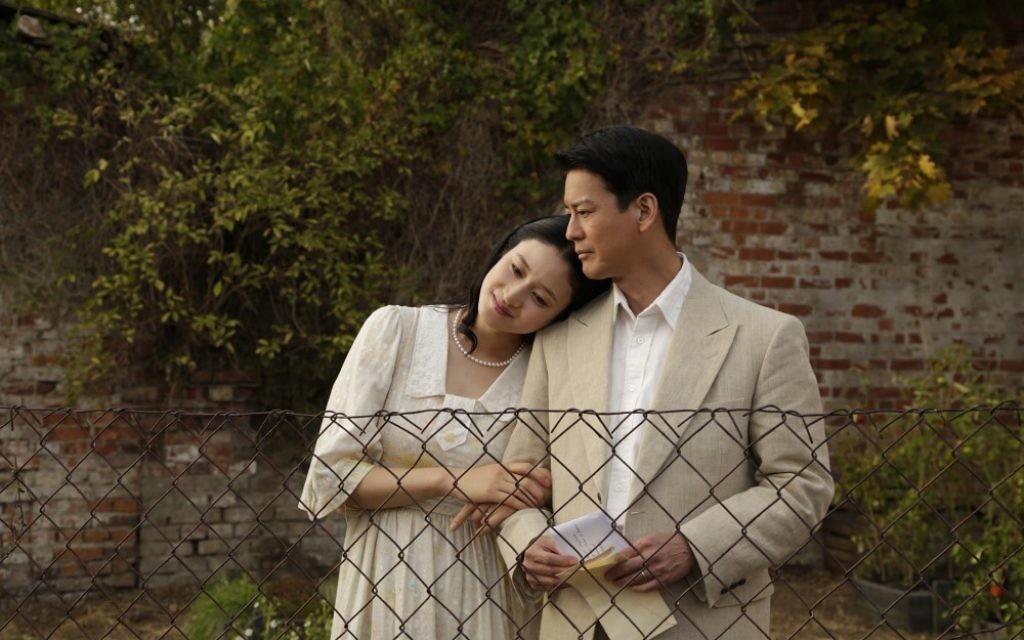AJFF: Unlikely Lineage Fits ‘Persona Non Grata’
I had the pleasure of speaking with Cellin Gluck, the filmmaker of “Persona Non Grata,” just before he left for Shabbat dinner this month at a friend’s house in L.A. In trying to understand his motivation for making a movie about a righteous Japanese ambassador during World War II, I had many questions about his background and upbringing. That’s where things got interesting and complex.
Born in Wakayama, Japan, Gluck is the son of a Japanese-American mother who was born and raised in California and a Jewish dad who grew up in a kosher home in New York. His mother’s family came to America from Japan in 1896, and she was born here in 1919.
Although American, Gluck’s mother was sent to the Japanese internment camp at Rohwer, Ark., in 1942, shortly after Pearl Harbor. “Yeah, that’s enough to make your skin crawl,” Gluck said. “There was the Oriental Exclusion Act. Orientals weren’t considered to be citizens; white guys couldn’t marry Orientals.”
Get The AJT Newsletter by email and never miss our top stories Free Sign Up
He added sarcastically, “I mean, you know, there’s a whole bunch of our history we should be real proud of.”
His mother later pursued her education and career in New York, where she met her future husband around 1946 after his voluntary service in the Navy. The couple ended up in Japan, where Gluck was born.
He spent his formative childhood in Japan, attending an American school.
“I say jokingly I didn’t know I was Asian until I came to America because in Japan, all of us whiteys and half-breeds, we were all considered to be non-Japanese. We were gaijin; we were foreigners. So I grew up being told by an entire nation that I was American,” Gluck said. “And then when you come to the States for the first time, you start finding hyphenated Americans — you know, Japanese-Americans, Mexican-Americans, German-Americans, Italian-Americans, kiss-me-I’m-Irish-American. What’s that all about? What’s wrong with just being American?”
As did most of his schoolmates, Gluck left Japan to go to college in the United States. He graduated from Pitzer College in California with honors from Pomona, still with no film experience but with a keen interest in theater. “I went to school to be an engineer, and then I graduated an actor.”
He went to New York to pursue acting and ended up working in advertising for a Japanese company. Although that job brought him to Japan a few months a year, directing his first commercial took him back to Los Angeles, where his work eventually evolved into filmmaking.
Because they had worked together on a previous project, Japanese Academy Award-winning actor Toshiaki Karasawa accepted the starring role in “Persona Non Grata” with the proviso that Gluck direct.
A project for the film division of Nippon Television, “Persona Non Grata” was created as a redemptive Japanese film marking the 70th anniversary of the end of World War II. It tells the story of Chiune Sugihara, the Japanese consul in Kaunas, Lithuania, during the war.
The movie shows the character development of Sugihara from a young statesman at the Japanese Foreign Ministry to an empathetic soul who, defying his government and at great personal risk, saved thousands of Jews by issuing them visas so they could leave Lithuania and escape Hitler’s grasp.
As a result of his actions, Sugihara became known by his government as a persona non grata, or an undesirable, so it is an appropriate name for the film.
“We wanted to create a film that would let the world know about Sugihara, but as I’m sure you get the feeling from the film, it’s the classic tale of a classic hero, in the sense that extraordinary things happening to ordinary people and the way in which they react is what creates a true hero,” Gluck said. “And that was our goal. He did what he believed was right, and his actions ended up making him a hero. He didn’t set out to become a hero. It found him. He was a man that was driven by his conscience.”
With meticulous attention to cinematography, costumes and set design and a sweeping musical score throughout, “Persona Non Grata” has the feel of a big-production movie epic. Gluck said, however, that the budget was $6 million, which is not large by Hollywood standards. The film was shot in Poland, then the director’s cut was prepared in Los Angeles. Post-production and a substantial amount of editing were done in Japan.
Gluck said the cherry blossoms are computer graphics, and Karasawa’s daughter designed the Japanese costumes.
Gluck made a point of saying he “was given the best of both worlds. … It makes perfect sense to have shot in Poland because, even though the events took place in Lithuania, most of the Jewish refugees that he saved were Polish Jews who had escaped to Lithuania.”
He spoke of having great Japanese actors whom he took to Poland, “the best of the Polish actors playing who they should be playing, which are Polish people,” and a talented Polish crew. He said he felt fortunate to be able to tell the story that way, which felt appropriate.
Although Gluck achieved acclaim and professional success in Japan for his work on films such as “Lorelei” (2005), “Sideways” (a 2009 remake of the American hit) and “Oba, the Last Samurai” (2011), “Persona” best brings together his rich and complicated Jewish-Japanese heritage to tell a story that needs to be told.






comments